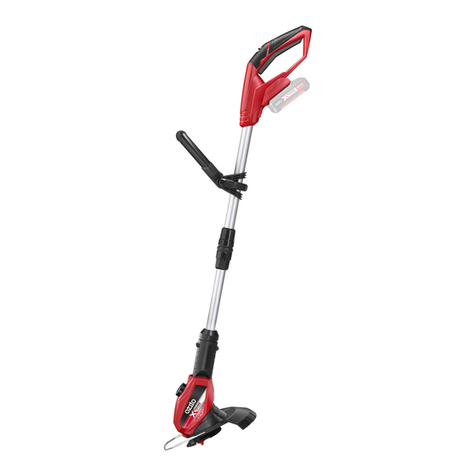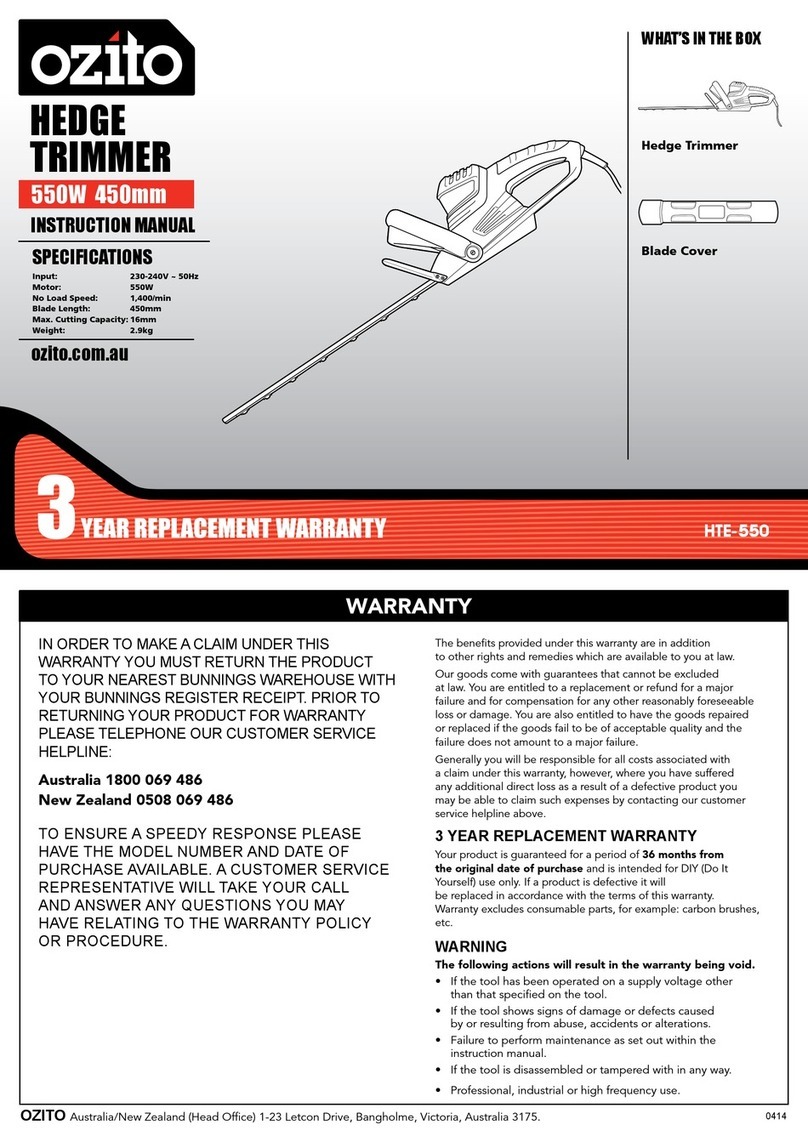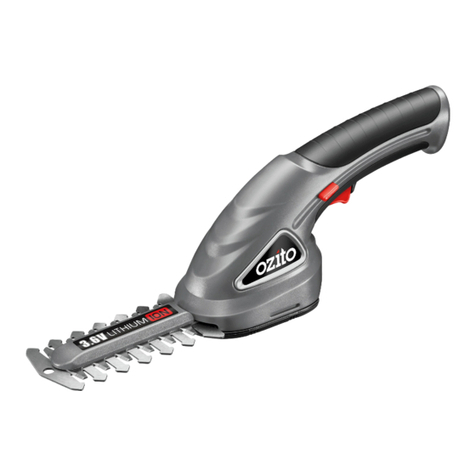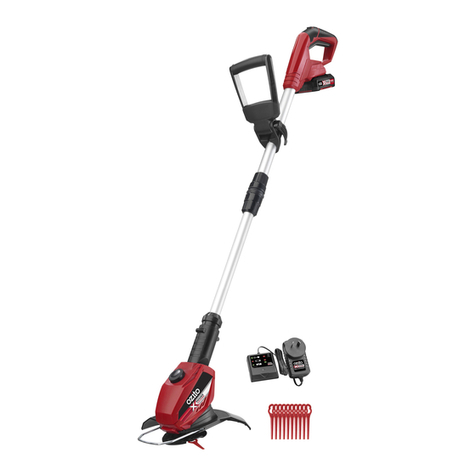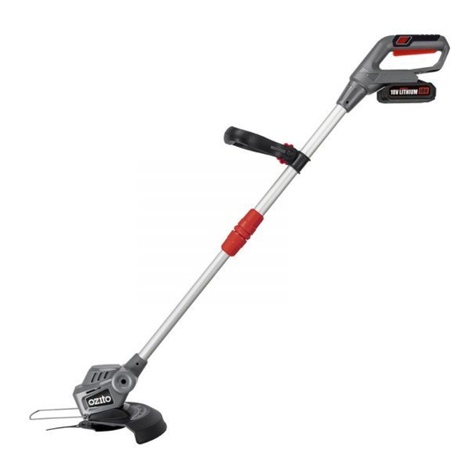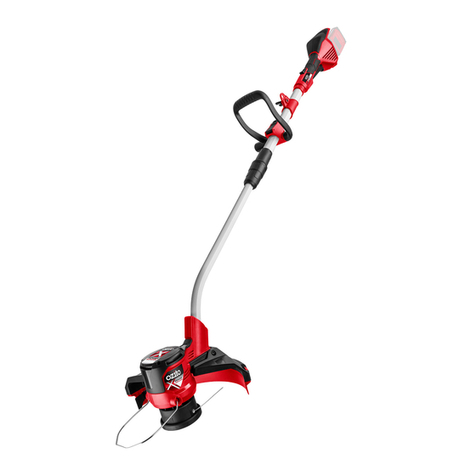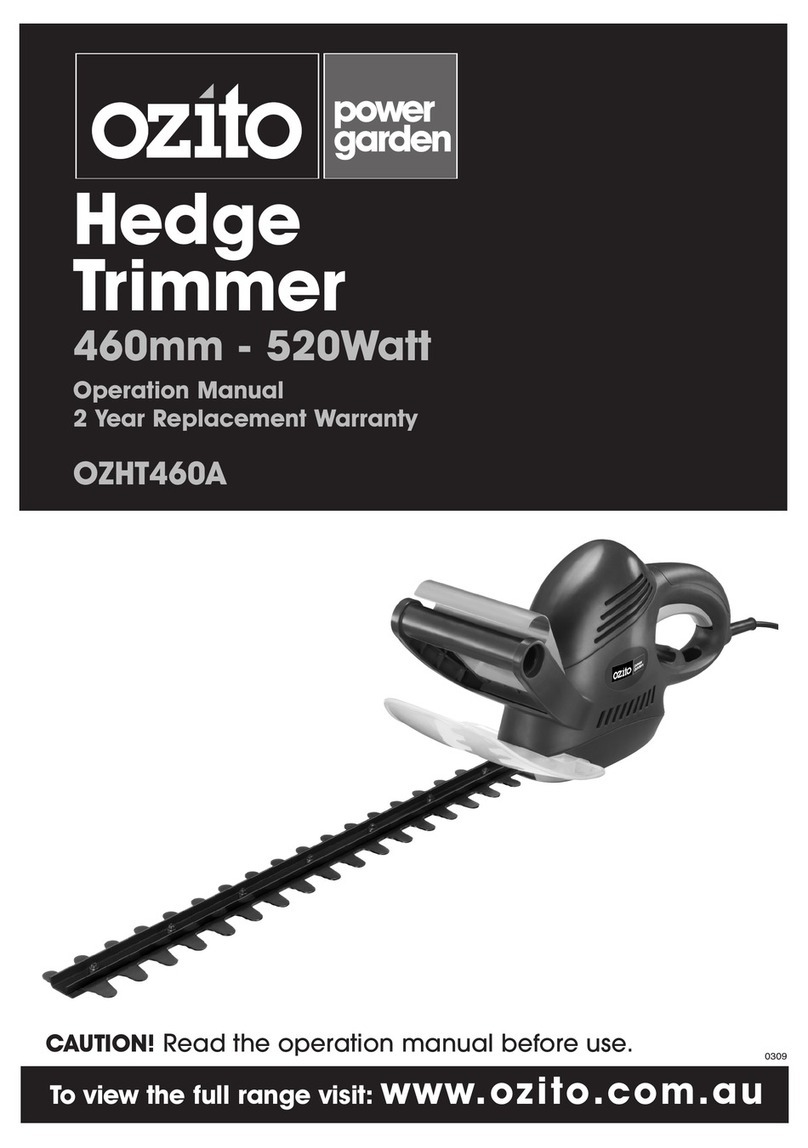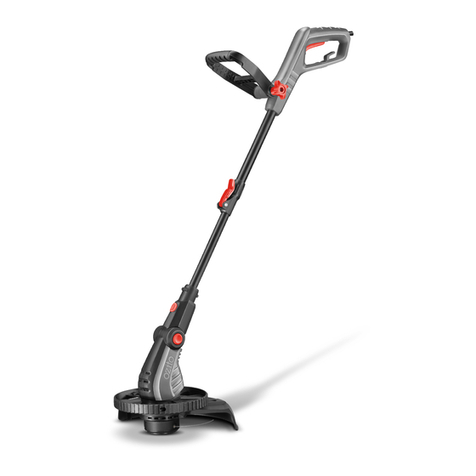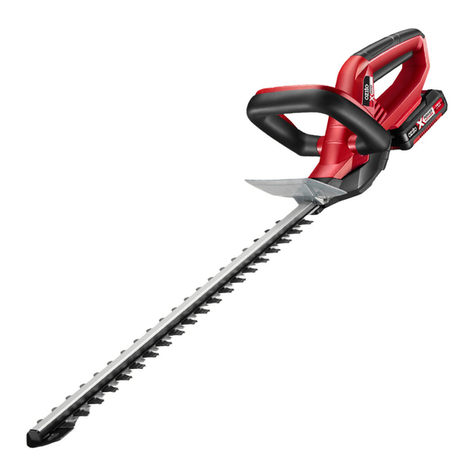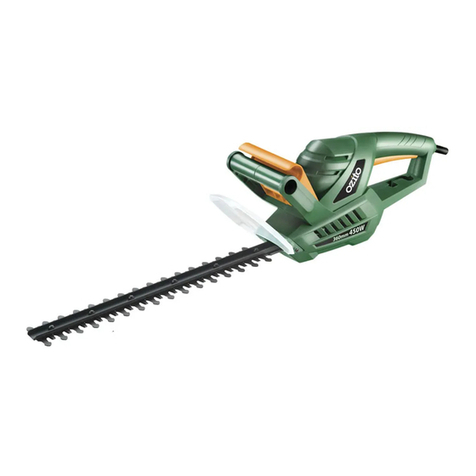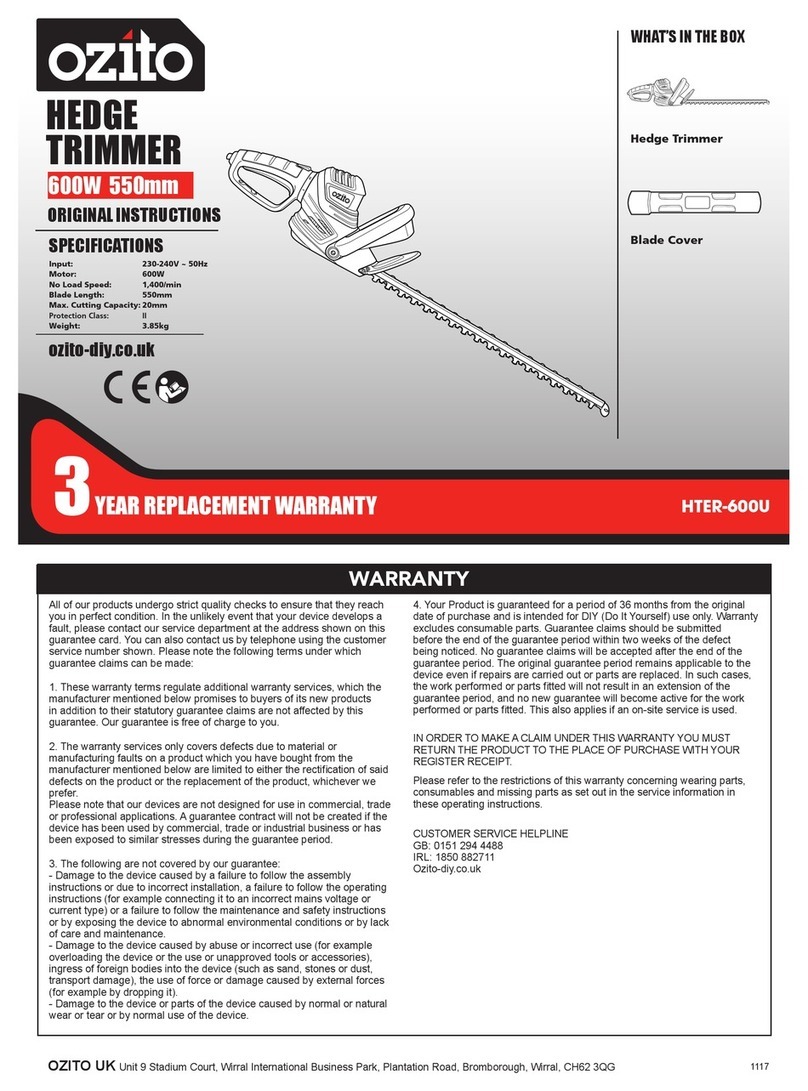This appliance is not intended for use by persons (including children) with reduced
physical, sensory or mental capabilities, or lack of experience and knowledge, unless
they have been given supervision or instruction concerning use of the appliance by a
person responsible for their safety.
• Never allow children or people unfamiliar with these instructions to use the line
trimmer.
• Avoid using the line trimmer, while people, especially children or pets, are nearby.
•Usethelinetrimmeronlyindaylightorgoodarticiallight.
• Never operate the line trimmer with damaged guards or without guards in place.
• Switch on the line trimmer only when the hands and feet are away from the cutting
head.
• Use only the manufacturer’s recommended replacement parts and accessories.
• Disconnect the spark plug from the line trimmer before carrying out maintenance or
cleaning work.
• Inspect and maintain the line trimmer regularly. Have the line trimmer repaired only
by an authorized repairer.
•Takecareagainstinjuryfromtheblade(s)ttedfortrimmingthecuttinglinelength.
After extending new cutting line, always return the line trimmer to its normal
operating position before switching on.
• Do not operate in a hazardous location. Such areas include where there is a risk of
explosion of petrol fumes, leaking gas or explosive dust.
•Donotoperateinaconnedarea.Exhaustgases,smokeorfumescouldreach
dangerous concentrations.
• Protect your tool. This line trimmer is NOT WEATHERPROOF and should not be
exposed to direct sunlight, high ambient temperature and damp, wet or high humidity
conditions.
• Do not smoke while refuelling. This is potentially dangerous as it may ignite the fuel
and cause an explosion.
• Take care not to spill fuel. When refuelling the line trimmer ensure that the motor
has been switched off. Prevent the spilling of fuel as this may also ignite with the hot
motor. Never refuel whilst the engine running.
• When not in use, store the line trimmer out of the reach of children.
• Face the cutting head away from yourself, other people and animals,especially
during operation.
• Disconnect the spark plug when changing spools or clearing grass from under
the guard.
• Disconnect the spark plug from the line trimmer before making any adjustments.
• Use both handles.
• Keep ventilation openings clear of debris. Keep handles dry, clean and free
of oil and grease.
• Keep your distance. The line trimmer emits exhaust fumes. Ensure bystanders keep
a safe distance.
• Ensure you use oil-mix fuel. Ensure that you mix 40 parts unleaded fuel to 1 part
2-stroke oil. If not, the engine will overheat and cause damage to your line trimmer.
• When using the trimmer, stones, pieces of metal and other objects can be thrown out
at high speed by the blade. The tool and guard are designed to reduce the danger.
However, the following special precautions should be taken:
- Wear safety glasses or other eye protection, gloves, long pants and suitable
footwear.
- Make sure that other people and pets are at least 5 metres away.
• Never reach underneath the line trimmer (the cutting line area) until it has completely
stopped and the power has been disconnected.
WARNING! When servicing, use only identical replacement parts. Use of any
other parts may create a hazard or cause product damage. To ensure safety
andreliability,allrepairsshouldbeperformedbyaqualiedservicetechnician.
WARNING!Thisapplianceisnotintendedforusebyyoungorinrmpersons
unless supervised by a responsible person to ensure that they can use the
appliance safely. Young children should be supervised to ensure that they do
not play with the appliance.
Read the whole manual carefully and make sure you know how to switch the tool off
in an emergency, before operating the tool.
Save these instructions and other documents supplied with this tool for future
reference.
WARNING! Read all safety warnings and all instructions. Failure to follow
thewarningsandinstructionsmayresultinelectricshock,reand/orserious
injury.
Save these instructions
RISK OF EXPLOSION OR FIRE
What can happen:
• Spilled petrol and its vapours can become ignited from cigarette sparks, electrical
arcing,exhaustgasesandhotenginecomponentssuchasthemufer.
•Heatwillexpandfuelinthetankwhichcouldresultinare.
•Operatingthetoolinanexplosiveenvironmentcouldresultinare.
•Muferexhaustheatcandamagepaintedsurfaces,meltanymaterialssensitiveto
heat (such as siding plastic, rubber or vinyl) and damage live plants. Keep hot tool
away from other objects.
• Improperly stored fuel could lead to accidental ignition. Fuel improperly secured
couldgetintothehandsofchildrenorotherunqualiedpersons.
How to prevent it:
• Shut off engine and allow it to cool before adding fuel to the tank.
•Usecarewhenllingthetanktoavoidspillingfuel.Movetoolawayfromfuelling
area before starting engine.
• Keep maximum fuel level 20mm below top of tank to allow for expansion.
• Operate and refuel in well ventilated areas free from obstructions.
•Storefuelinaapprovedcontainer(AS/NZS2906-1999)forpetrol.Storeina
secure location away from the work area. Make sure the container is clearly
marked “fuel”.
RISK TO BREATHING
What can happen:
• Breathing exhaust fumes can cause serious injury or death.
How to prevent it:
• Operate tool in a well ventilated area. Avoid enclosed areas.
• Never operate unit in a location occupied by other people or animals.
SAVE THESE INSTRUCTIONS
1) Work area
a)Keep work area clean and well lit. Cluttered and dark areas invite accidents.
b)
Do not operate petrol tools in explosive atmospheres, such as in the presence
of ammable liquids, gases, or dust. Power tools create sparks which may ignite
the dust or fumes.
c)Keep children and bystanders away while operating a petrol tool.
Distractions can cause you to lose control.
2) Personal safety
a)Stay alert, watch what you are doing and use common sense when operating
a petrol tool.Donotuseapowertoolwhileyouaretiredorundertheinuenceof
drugs, alcohol, or medication. A moment of inattention while operating power tools
may result in serious personal injury.
b)Use safety equipment. Always wear eye protection. Safety equipment such
as a dust mask, non-skid safety shoes, hard hat, or hearing protection used for
appropriate conditions will reduce personal injuries.
c)Remove any adjusting key or wrench before turning the tool on. A wrench or
a key that is left attached to a rotating part of the petrol tool may result in personal
injury.
d)Do not overreach. Keep proper footing and balance at all times. This enables
better control of the petrol tool in unexpected situations.
e)Dress properly. Do not wear loose clothing or jewellery. Keep your hair,
clothing and gloves away from moving parts. Loose clothes, jewellery or long hair
can be caught in moving parts.
f) If devices are provided for the connection of dust extraction and collection
facilities ensure that these are connected and properly used. Use of these
devices can reduce dust-related hazards.
3) Petrol tool use and care
a)Do not force the petrol tool. Use the correct petrol tool for your application.
The correct petrol tool will do the job better and safer at the rate for which it was
designed.
b)Do not use the petrol tool if the switch does not turn it on and off. Any petrol
tool that cannot be controlled with the switch is dangerous and must be repaired.
c)Turn tool off completely before making any adjustments, changing
accessories, or storing petrol tools. Such preventive safety measures reduce
the risk of starting the petrol tool accidentally. Hair can be caught in moving parts.
d)Store idle petrol tools out of the reach of children and do not allow persons
unfamiliar with the petrol tool or these instructions to operate the petrol tool.
Petrol tools are dangerous in the hands of untrained users.
e)Maintain petrol tools. Check for misalignment or binding of moving parts,
breakage of parts and any other condition that may affect the petrol tool’s
operation. If damaged, have the petrol tool repaired before use. Many accidents
are caused by poorly maintained petrol tools.
f) Keep cutting tools sharp and clean. Properly maintained cutting tools with sharp
cutting edges are less likely to bind and are easier to control.
g)Use the petrol tool, accessories and tool bits etc., In accordance with these
instructions and in the manner intended for the particular type of petrol tool,
taking into account the working conditions and the work to be performed.
Use of the petrol tool for operations different from intended could result in a
hazardous situation.
h)This appliance is not intended for use by persons (including children) with
reduced physical, sensory or mental capabilities, or lack of experience and
knowledge, unless they have been given supervision or instruction concerning use
of the appliance by a person responsible for their safety.
i) Children should be supervised to ensure that they do not play with the
appliance.
4) Service
a) Have your petrol tool serviced by a qualied repair personnel using only
identical replacement parts. This will ensure that the safety of the petrol tool is
maintained.
SAFETY INSTRUCTIONS FOR PETROL LINE TRIMMERS
SAFETY INSTRUCTIONS



